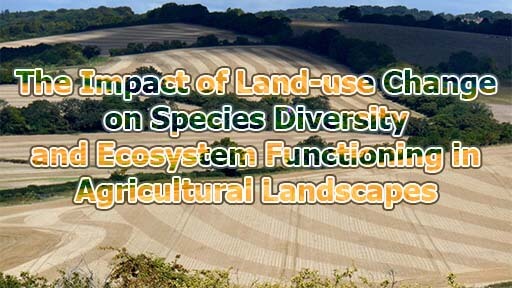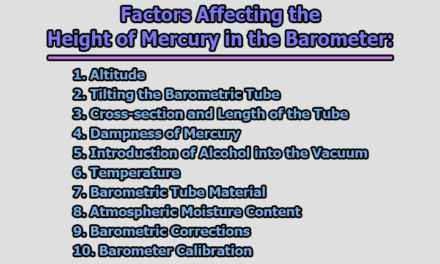The Impact of Land-use Change on Species Diversity and Ecosystem Functioning in Agricultural Landscapes:
Land-use change is one of the main drivers of biodiversity loss and ecosystem degradation worldwide. Agricultural expansion, intensification, and abandonment have been identified as major causes of land-use change in many parts of the world. These changes can have significant impacts on species diversity and ecosystem functioning in agricultural landscapes. In this article, we will examine the impact of land-use change on species diversity and ecosystem functioning in agricultural landscapes, focusing on the factors that influence these impacts and the potential mechanisms that underlie them.

Agricultural Landscapes and Land-Use Change:
Agricultural landscapes are areas of land that are predominantly used for agricultural purposes, such as crop cultivation and livestock production. They are often characterized by a mosaic of different land-use types, including cropland, pasture, woodland, and wetland. The management of agricultural landscapes can have a significant impact on biodiversity and ecosystem functioning.
Land-use change is a major driver of biodiversity loss and ecosystem degradation in agricultural landscapes. Agricultural expansion, intensification, and abandonment have all been identified as key drivers of land-use change. Agricultural expansion involves the conversion of natural ecosystems, such as forests and grasslands, into agricultural land. This can lead to the loss of biodiversity and ecosystem functions associated with these ecosystems. Agricultural intensification involves the increased use of inputs such as fertilizers, pesticides, and irrigation, in order to increase crop yields. This can have negative impacts on biodiversity and ecosystem functions, such as soil health, water quality, and pollination services. Agricultural abandonment occurs when agricultural land is no longer used for production. This can lead to the succession of natural ecosystems, such as forests and grasslands, and the recovery of biodiversity and ecosystem functions associated with these ecosystems.
Impact of Land-Use Change on Species Diversity:
The impact of land-use change on species diversity in agricultural landscapes depends on a number of factors, including the type of land-use change, the scale of the change, and the characteristics of the surrounding landscape.
Agricultural expansion can have significant negative impacts on species diversity, particularly when natural ecosystems are converted to agriculture. This can result in the loss of habitat for native species, the fragmentation of the remaining habitat, and the isolation of populations. These impacts are particularly pronounced when the scale of the conversion is large and when the surrounding landscape is dominated by agriculture. For example, a study of bird communities in the Brazilian Cerrado found that the conversion of natural grassland to soybean production resulted in a significant loss of species richness and abundance (Pardini et al. 2010).
Agricultural intensification can also have negative impacts on species diversity, particularly when it involves the use of pesticides and other chemicals. These chemicals can have direct toxic effects on non-target species, such as pollinators and soil organisms, and can also lead to the loss of food resources for these species. Intensification can also lead to the simplification of agricultural landscapes, reducing habitat complexity and diversity. However, there are also cases where agricultural intensification can have positive impacts on species diversity, particularly when it involves the adoption of sustainable practices such as agroforestry and organic farming. These practices can increase habitat diversity and provide refuge for native species (Bommarco et al. 2013).
Agricultural abandonment can have both positive and negative impacts on species diversity, depending on the characteristics of the abandoned land and the surrounding landscape. In some cases, abandoned agricultural land can provide important habitat for native species, particularly when it is located in a matrix of natural ecosystems. Abandoned land can also provide opportunities for ecological restoration and the recovery of ecosystem functions. However, abandoned land can also become degraded and invaded by non-native species, particularly when it is located in a matrix of agricultural land.
Impact of Land-Use Change on Ecosystem Functioning:
The impact of land-use change on ecosystem functioning in agricultural landscapes is complex and can vary depending on the type of land-use change, the scale of the change, and the characteristics of the surrounding landscape. However, some general trends can be identified.
Agricultural expansion can have significant negative impacts on ecosystem functioning, particularly when natural ecosystems are converted to agriculture. This can lead to the loss of important ecosystem functions, such as carbon sequestration, water regulation, and nutrient cycling. The conversion of natural ecosystems to agriculture can also lead to soil degradation, erosion, and loss of fertility, which can further degrade ecosystem functioning. For example, a study in South Africa found that the conversion of natural grassland to commercial forestry resulted in a significant decrease in soil carbon and nitrogen content (Elliott et al. 2013).
Agricultural intensification can also have negative impacts on ecosystem functioning, particularly when it involves the use of chemical inputs such as fertilizers and pesticides. These inputs can lead to the contamination of soils, water, and air, and can have negative impacts on ecosystem functions such as soil health, water quality, and pollination services. However, as mentioned earlier, sustainable practices such as agroforestry and organic farming can have positive impacts on ecosystem functioning by increasing soil health, biodiversity, and nutrient cycling.
Agricultural abandonment can have both positive and negative impacts on ecosystem functioning, depending on the characteristics of the abandoned land and the surrounding landscape. Abandoned agricultural land can provide important opportunities for ecological restoration and the recovery of ecosystem functions. For example, a study in Europe found that the restoration of abandoned farmland resulted in increased carbon sequestration, soil fertility, and biodiversity (Kleijn et al. 2015). However, abandoned land can also become degraded and invaded by non-native species, particularly when it is located in a matrix of agricultural land.
Potential Mechanisms Underlying the Impact of Land-Use Change:
The impact of land-use change on species diversity and ecosystem functioning in agricultural landscapes is influenced by a number of underlying mechanisms, including habitat loss and fragmentation, chemical contamination, and simplification of agricultural landscapes.
Habitat loss and fragmentation are key mechanisms underlying the negative impacts of land-use change on species diversity and ecosystem functioning. Habitat loss reduces the availability of habitat for native species, while habitat fragmentation can isolate populations and reduce gene flow, leading to reduced genetic diversity and increased extinction risk. For example, a study in Europe found that the fragmentation of agricultural landscapes resulted in a significant loss of bird species richness and abundance (Fischer et al. 2014).
Chemical contamination is another important mechanism underlying the negative impacts of land-use change on species diversity and ecosystem functioning. The use of chemical inputs such as fertilizers and pesticides can have direct toxic effects on non-target species, such as pollinators and soil organisms, and can also lead to the loss of food resources for these species. For example, a study in Europe found that the use of pesticides in agricultural landscapes resulted in a significant decline in butterfly populations (van der Sluijs et al. 2013).
Simplification of agricultural landscapes is another mechanism underlying the negative impacts of land-use change on species diversity and ecosystem functioning. Simplification reduces habitat complexity and diversity, leading to a loss of niche opportunities for native species. For example, a study in Europe found that the simplification of agricultural landscapes resulted in a significant decline in bird species richness and abundance (Donald et al. 2001).
In conclusion, land-use change is a major driver of biodiversity loss and ecosystem degradation in agricultural landscapes. Agricultural expansion, intensification, and abandonment can all have significant impacts on species diversity and ecosystem functioning, depending on the type of land-use change, the scale of the change, and the characteristics of the surrounding landscape. The impact of land-use change on species diversity and ecosystem functioning is influenced by a number of underlying mechanisms, including habitat loss and fragmentation, chemical contamination, and simplification of agricultural landscapes.
However, sustainable land-use practices such as agroforestry and organic farming can have positive impacts on ecosystem functioning by increasing soil health, biodiversity, and nutrient cycling. Additionally, abandoned agricultural land can provide important opportunities for ecological restoration and the recovery of ecosystem functions.
Therefore, in order to mitigate the negative impacts of land-use change on species diversity and ecosystem functioning, it is important to promote sustainable land-use practices and prioritize ecological restoration in abandoned agricultural lands. This can be achieved through policy measures such as incentivizing sustainable land-use practices, supporting farmers to transition towards more sustainable practices, and providing financial and technical support for ecological restoration projects.
Furthermore, it is important to promote landscape-level approaches to land-use planning and management that prioritize the conservation and restoration of ecological connectivity and habitat corridors. This can help to mitigate the negative impacts of habitat fragmentation and loss and support the recovery of species diversity and ecosystem functioning in agricultural landscapes.
Finally, land-use change is a complex issue with significant implications for species diversity and ecosystem functioning in agricultural landscapes. However, by promoting sustainable land-use practices, prioritizing ecological restoration in abandoned agricultural lands, and promoting landscape-level approaches to land-use planning and management, it is possible to mitigate the negative impacts of land-use change and support the recovery of biodiversity and ecosystem functioning in agricultural landscapes.
References:
- Donald, P. F., Green, R. E., & Heath, M. F. (2001). Agricultural intensification and the collapse of Europe’s farmland bird populations. Proceedings of the Royal Society B: Biological Sciences, 268(1462), 25-29.
- Elliott, J. L., Harding, J. S., & Wilkie, K. T. (2013). Conversion of grassland to commercial forestry reduces soil carbon and nitrogen and increases emissions of nitrous oxide and methane. Agriculture, Ecosystems & Environment, 165, 13-22.
- Fischer, J., Abson, D. J., Butsic, V., Chappell, M. J., Ekroos, J., Hanspach, J., … & von Wehrden, H. (2014). Land sparing versus land sharing: moving forward. Conservation Letters, 7(3), 149-157.
- Kleijn, D., Kohler, F., Báldi, A., Batáry, P., Concepción, E. D., Clough, Y., … & Herzog, F. (2015). On the relationship between farmland biodiversity and land-use intensity in Europe. Proceedings of the Royal Society B: Biological Sciences, 282(1799), 2015-2447.
- van der Sluijs, J. P., Amaral‐Rogers, V., Belzunces, L. P., Bijleveld van Lexmond, M. F., Bonmatin, J. M., Chagnon, M., … & Dorne, J. L. (2013). Conclusions of the worldwide integrated assessment on the risks of neonicotinoids and fipronil to biodiversity and ecosystem functioning. Environmental Science and Pollution Research, 20(5), 5-11.
- Meehan, T. D., Gratton, C., Diehl, E., Hunt, N. D., Mooney, D. F., & Ventura, S. J. (2013). Ecosystem services from agriculture: steps for expanding the paradigm. Ecology and Society, 18(3), 1-14.
- Perfecto, I., Vandermeer, J., & Wright, A. (2009). Nature’s matrix: Linking agriculture, conservation, and food sovereignty. Routledge.
- Tscharntke, T., Clough, Y., Wanger, T. C., Jackson, L., Motzke, I., Perfecto, I., & Vandermeer, J. (2012). Global food security, biodiversity conservation, and the future of agricultural intensification. Biological Conservation, 151(1), 53-59.
- Turner, E. C., Lambers, J. H., Stouffer, D. B., Gourevitch, J. D., & Burgess, H. K. (2021). Agricultural lands account for a smaller proportion of global biodiversity than previously estimated. Nature Sustainability, 4(2), 155-163.
- Westphal, C., Steffan-Dewenter, I., & Tscharntke, T. (2003). Mass flowering crops enhance pollinator densities at a landscape scale. Ecology Letters, 6(10), 961-965.
- Wickramasinghe, A., & van der Hoek, R. (2019). Agroforestry as a sustainable land use practice in Sri Lanka: A review. Agroforestry Systems, 93(3), 1053-1065.
- Zhang, W., Ricketts, T. H., Kremen, C., Carney, K., & Swinton, S. M. (2007). Ecosystem services and dis-services to agriculture. Ecological Economics, 64(2), 253-260.

Library Lecturer at Nurul Amin Degree College









